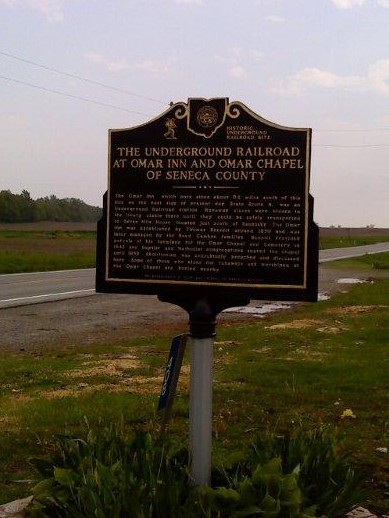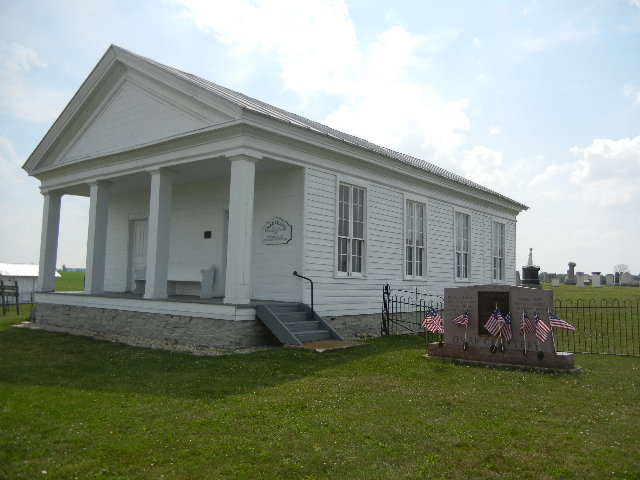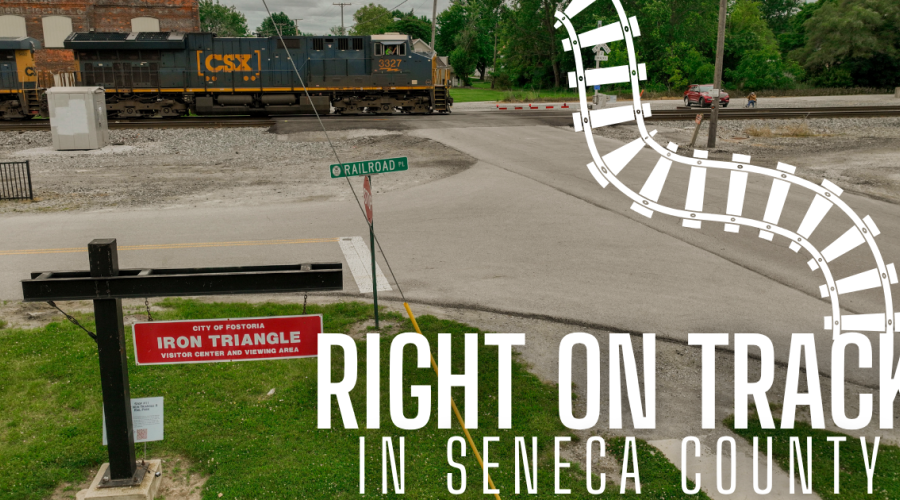
Secrets of Seneca County Historical Driving Tour | The Omar Inn, Chapel, & Cemetery
Embark on a captivating journey through the wondrous past of Seneca County, Ohio, with the Secrets of Seneca County Historical Driving Tour! The next stop on the journey is: The Omar Inn, Chapel, & Cemetery (408 OH-4, Attica, OH 44807, Stop #13)
Thomas Bennitt opened the Omar Inn around 1830, just six years after Seneca County was established. It later became a “station” on the Underground Railroad for runaways escaping slavery in the South. Before 1850, runaways tended to be safe simply by crossing into a free state. In that year passage of the Federal Fugitive Slave Act allowed slave owners legally to follow their runaway slaves into free states to recapture them. This meant that runaways now had to reach Canada to avoid being returned. The owners of the Omar Inn provided shelter for the fleeing slaves in their livery barn, feeding and protecting them until they could be moved secretly north to Sandusky for passage across Lake Erie and freedom in Canada. The building no longer stands, but a plaque explaining its important role in the Underground Railroad stands near the Inn’s original site.
 In 1842, Bennitt provided land for the Omar Chapel and Cemetery. The chapel, which is in the Greek Revival style, was completed the following year. At that time, it was known as the Second Regular Baptist Church of Reed County. A tornado did serious damage to the roof in 1953, but the repairs were made, and the building was saved. Today the church is maintained by dedicated volunteers.
In 1842, Bennitt provided land for the Omar Chapel and Cemetery. The chapel, which is in the Greek Revival style, was completed the following year. At that time, it was known as the Second Regular Baptist Church of Reed County. A tornado did serious damage to the roof in 1953, but the repairs were made, and the building was saved. Today the church is maintained by dedicated volunteers.
The Omar cemetery contains the remains of many former congregants, including some who helped runaway slaves before the Civil War. One other grave, that of Belle Bowen, is notable for what it can tell us about life in the late 1800s. The 17-year-old died in 1888 of tuberculosis and was interred in the cemetery. An acquaintance of Belle’s, Martin Wilson, was then a student at the Toledo Medical College, and he had a problem. He didn’t have enough money to complete his current semester, but he had an idea. Medical schools at the time faced a perplexing problem; they had to prepare students to become practicing physicians but were prevented by Ohio law from dissecting corpses to help them understand the human body. Undeterred, most colleges looked the other way as students and others simply opened graves of the recently deceased and secretly brought the bodies to the schools. Those delivering the corpses generally received compensation.
 Wilson made a deal with the Toledo Medical College to deliver a body, Miss Bowen’s, in return for cancelling his outstanding tuition. One night a short time later, Wilson and several friends visited the Omar Cemetery, retrieved Miss Bowen’s body, and then closed the empty coffin and refilled the grave to cover their crime. He decided to forward the body to Toledo by train in a trunk. Unfortunately for Wilson, the plot was discovered when the trunk arrived at the Toledo station. The body was returned and reinterred at the Omar Cemetery. Wilson was arrested, convicted, and spent a brief time in prison. Upon his release, he returned to school and completed his degree. He eventually became a popular member of the community and a highly respected physician, dying at the bedside of one of his patients.
Wilson made a deal with the Toledo Medical College to deliver a body, Miss Bowen’s, in return for cancelling his outstanding tuition. One night a short time later, Wilson and several friends visited the Omar Cemetery, retrieved Miss Bowen’s body, and then closed the empty coffin and refilled the grave to cover their crime. He decided to forward the body to Toledo by train in a trunk. Unfortunately for Wilson, the plot was discovered when the trunk arrived at the Toledo station. The body was returned and reinterred at the Omar Cemetery. Wilson was arrested, convicted, and spent a brief time in prison. Upon his release, he returned to school and completed his degree. He eventually became a popular member of the community and a highly respected physician, dying at the bedside of one of his patients.
The Omar Chapel was originally built as a Baptist Church in 1842 and now is open to all who wish to pause there. The property has been placed on the National Register of Historical Places by the Department of the Interior. Early settlers organized a Baptist church in Omar in 1836, which quickly grew to 63 members. After they outgrew the schoolhouse, they built Omar Chapel in 1842. Membership continued to grow due to winter revivals.
But the church began to decline as early as 1856. Membership remained in the twenties and services were held two Sunday afternoons a month, if at all, from the late 1850’s until the church closed in 1911. For this reason we have this historical treasure today, little changed from its original appearance.
As they entered the church, men entered the south door, and women, the north door. They sat on opposite sides, as was common in those days. The men sat on the south side, where the deacons’ corner (or “amen corner”) is located, with the deacons’ seats facing the pulpit. Women sat on the north side. A stove was near the northeast corner with three small pews behind it. One pew was turned toward the stove. These seats were reserved for women with babies and small children in churches of that era. Three pews were later removed from the south side and a second stove was installed for the men. Two stovepipes crossed to the center of the sanctuary and went into a central chimney, the opening of which is still visible. A brass oil chandelier hung in the center and oil lamps with reflectors hung on the side walls. There were outside shutters on the windows.
The choirloft and platform were covered with ingrain carpet at a later date and it remains today. This type of carpet was manufactured between 1860 and 1880, and had the same pattern on both sides in reverse colors. It could be flipped over when worn or faded. This was known as poor man’s carpet and it would be thrown away when it became worn through or when better carpet could be afforded. Thus, few examples of ingrain carpet survive today. The primitive Windsor bowback chairs were probably in the choirloft originally. The Bible on the pulpit is dated 1855 and has been rebound. It was presented by the family of the man who surveyed the cemetery. There were probably no musical instruments at first, as early Baptists believed that the human voice was the only instrument fit to praise God. In some churches a bass or viola was used. Eventually the church purchased a pump organ. They had to put screen around the lower part to keep mice out of the bellows.
The chapel and cemetery are now managed by volunteers.


